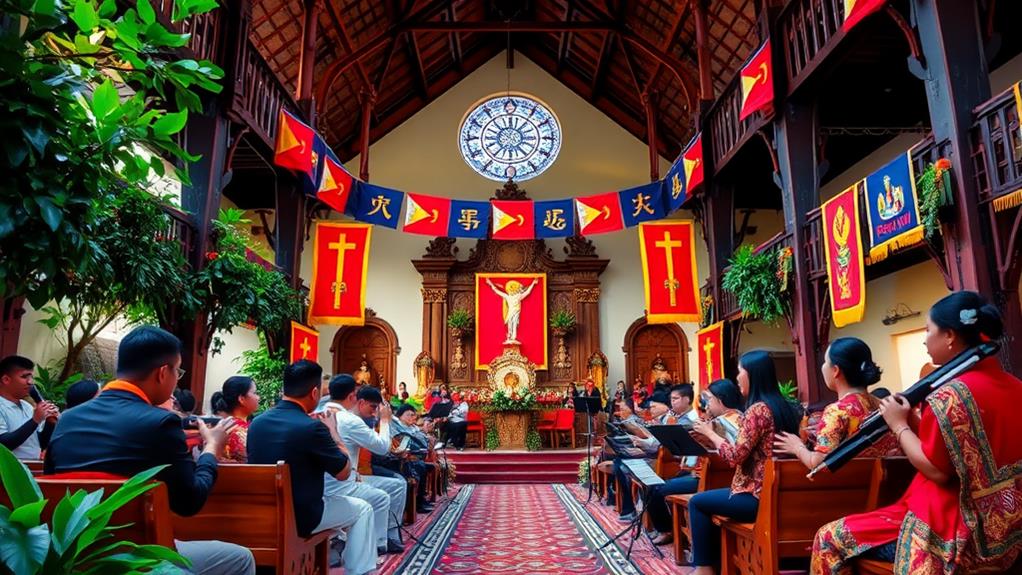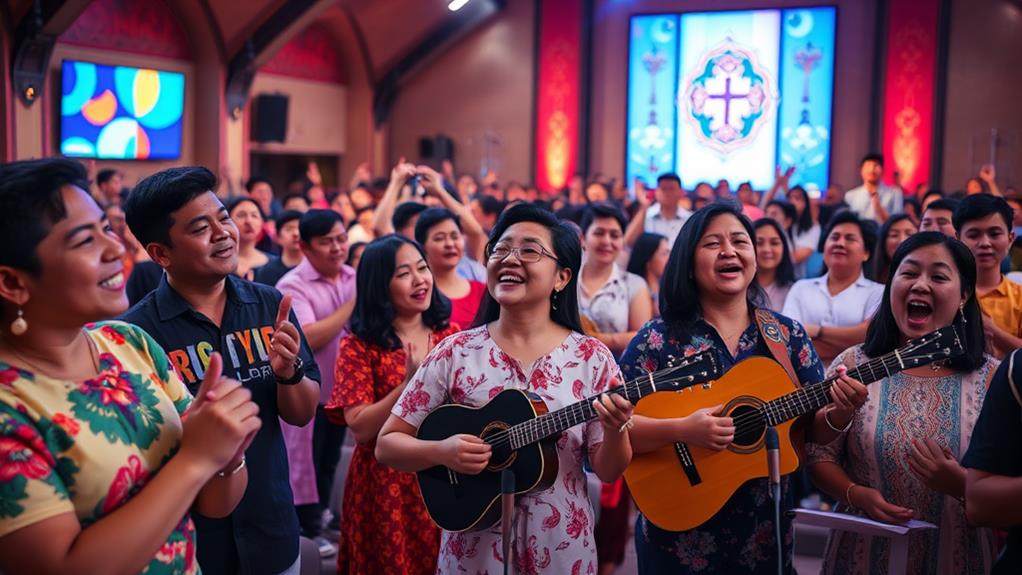Religion and Music Intertwine in the Philippines
In the Philippines, religion and music are deeply connected, creating a unique cultural identity. This blend is evident in traditional hymns rooted in Catholicism, which coexist with vibrant Protestant influences that enrich local worship practices.
Indigenous Instruments Add Depth
Traditional instruments like bamboo sticks and gongs are integral to these musical traditions, adding depth and cultural significance. These instruments are often used in festivals, which celebrate community and identity through music and dance.
Contemporary Worship Evolves
Modern styles and technology have been incorporated into contemporary worship, fostering emotional connections among worshippers. This blend of traditional and modern elements embodies a unique dialogue between tradition and modernity within Filipino spirituality.
By exploring this dynamic relationship, you'll uncover the significance of sacred sounds in the Philippines, where music and religion blend beautifully to create a rich cultural heritage.
Historical Roots of Sacred Music

The historical roots of sacred music in the Philippines are deeply intertwined with the nation's colonial past and cultural evolution. When Ferdinand Magellan arrived in 1521, he introduced Catholicism, which laid the foundation for the country's sacred musical traditions. This blending of indigenous beliefs with Catholic rituals created a unique tapestry of religious traditions.
The Spanish-American War in 1898 brought about a significant change in the country's sacred music. Protestant missionaries introduced new styles of liturgical music, diversifying the sacred soundscape. For example, Protestant hymns and choruses were incorporated into worship services, leading to a more diverse range of musical styles.
In the 1950s and 1960s, Filipino hymnody flourished. This period saw the merging of Western melodies with local dialects, enriching worship experiences. For instance, Filipino composers created hymns that combined traditional melodies with local languages, making worship more accessible and meaningful to the congregation.
Traditional instruments have been replaced by more accessible ones in contemporary worship. Although indigenous instruments like bamboo sticks and gongs hold historical significance, contemporary worship often leans on more accessible instruments, such as guitars and tambourines, which resonate with the modern congregation.
The adoption of English further facilitated the integration of American worship music, influencing current church practices.
Indigenous Instruments and Their Significance
Indigenous Instruments in the Philippines: Preserving Cultural Heritage
Traditional Music and Rituals
In the Philippines, Indigenous instruments like bamboo sticks, xylophones, nose flutes, and gongs are integral to traditional music and religious rituals. The kulintang, a gong-chime ensemble, plays a vital role in Indigenous ceremonies, accompanying dances that connect the community with their spiritual beliefs.
Underrepresentation in Church Settings
Although Western instruments like guitars and tambourines are commonly used in contemporary worship, Indigenous instruments are often overlooked.
This omission neglects the profound cultural significance of these instruments.
Diverse Cultural Landscape
Each ethnic group contributes unique sounds and playing techniques, creating a rich tapestry of music that reflects the Philippines' diverse cultural landscape.
For instance, the Maguindanao people are known for their kulintang ensembles, while the Ifugao people are skilled in playing the nose flute.
Reviving Indigenous Musical Traditions
Reviving Indigenous musical traditions is crucial for nurturing cultural identity and preserving ancestral knowledge.
By incorporating these instruments into religious practices, you can enrich the worship experience and honor the deep-rooted connections between music and spirituality that have flourished for generations.
Celebrating and Sustaining Cultural Heritage
Embracing Indigenous instruments allows you to celebrate and sustain the Philippines' unique musical heritage and its spiritual essence.
This not only promotes cultural preservation but also fosters a deeper appreciation for the country's rich cultural diversity.
Contemporary Worship Practices

Contemporary worship practices in the Philippines combine traditional and modern elements, creating a dynamic atmosphere for spiritual expression. This fusion results in a unique worship experience that reflects local religious beliefs and Western musical traditions.
Music styles blend seamlessly. Traditional hymns are mixed with contemporary Christian music, enriching the worship experience and appealing to diverse congregations. For instance, a traditional Filipino hymn might be played with modern instruments, creating a fresh sound that resonates with both old and young.
Large churches, inspired by American worship styles, create an energetic environment. Multiple musicians perform together, enhancing collective participation and creating a lively atmosphere. This setup encourages congregational singing and engagement.
Technology use varies by congregation. Wealthier churches often use advanced technologies like projectors to display lyrics, while less affluent churches may stick to traditional hymnals. The choice of technology depends on the congregation's resources.
Music fosters emotional connections and engagement. The emotional connections formed through music significantly boost congregational involvement, fostering a sense of community and spiritual engagement among attendees. This emotional connection is key to a meaningful worship experience.
This unique blend of musical styles showcases the Philippines' rich cultural tapestry. It transforms worship into an inclusive and vibrant expression of faith, resonating deeply with the hearts of Filipinos.
The Role of Festivals and Community
Festivals in the Philippines are a vibrant expression of the nation's cultural and religious heritage. These events, such as Sinulog and Pahiyas, showcase the deep integration of music and dance, where local cultural communities come alive in colorful displays of devotion.
Festivals foster unity among people, bringing them together to honor patron saints and celebrate shared traditions. Everyone participates, whether through vibrant processions or lively performances, blending contemporary Christian music with traditional hymns. This fusion highlights the evolution of worship styles and reinforces cultural identity.
Festivals serve as vital platforms for cultural preservation and education, allowing for intergenerational dialogue among community members. Through shared rituals and musical expressions, these festivals create lasting bonds, ensuring that the rich tapestry of Filipino culture remains vibrant and alive for generations to come.
How Does Music Play a Role in Sacred Filipino Religious Practices?
Music plays a crucial role in Filipino religious practices, intertwining with the rich cultural traditions. It serves as a vehicle for spiritual expression and fosters a sense of communal devotion. The role of religion in filipino art is evident in the harmonious melodies and rhythmic chants that elevate the sacred atmosphere during religious rituals.
Music as a Healing Tool

In various Filipino communities, music plays a vital role in healing practices, serving as a powerful tool that connects the physical and spiritual realms. Music and sound evoke deep emotional responses, enhancing the healing process.
Invocation of Deities: Specific songs and chants are used to invoke divine powers, establishing a connection to spiritual beliefs that guide the healing journey. For instance, in some Filipino rituals, traditional chants are sung to summon the help of ancestors or deities, believing that their presence will aid in the healing process.
Community Participation: Healing practices often bring together communities, fostering a collective spirit that amplifies the healing energy through shared musical experiences. In these communal gatherings, people come together to sing, dance, or play instruments, creating a unified energy that supports the healing process.
Cultural Identity: Traditional songs like the Sinulog and Subli serve not just as melodies but as expressions of cultural resilience, especially in post-colonial contexts. These songs preserve the cultural heritage of the community, providing a sense of identity and continuity.
Emotional Resonance: The intensity of the music reflects the cultural significance of healing, enabling both personal and communal transformation through sound.
In Filipino healing rituals, the emotional resonance of music is believed to awaken the body's natural healing abilities, promoting balance and harmony within the individual.
Dialogue Between Tradition and Modernity
Filipino Worship: A Blend of Tradition and Modernity
In the Filipino worship landscape, a dynamic dialogue unfolds between tradition and modernity, shaping the musical experience within churches across the nation.
This blend of traditional hymns and contemporary worship music reflects diverse congregational preferences.
Characteristics of Traditional Hymns and Contemporary Worship Music
Traditional Hymns
- Rooted in history, traditional hymns often evoke a sense of nostalgia.
- They're typically sung from hymnals, featuring simple melodic lines that appeal to older generations.
Contemporary Worship Music
- Reflecting modern values, contemporary worship music often features complex arrangements that engage younger congregants.
- Lyrics are frequently displayed via projectors, making it easier for worshipers to follow along.
The Emergence of Contemporary Christian Music
Since the 1970s, contemporary Christian music has emerged in the Philippines, fueled by local songwriting festivals that embraced Western influences.
Affluent congregations often employ technology, such as sound systems and multimedia presentations, to enhance worship experiences.
The Need for Balance
Ongoing discussions emphasize the need for balance, ensuring that the rich legacy of traditional hymnody remains integral while allowing contemporary sounds to flourish.
This dialogue enriches community experiences and fosters deeper emotional connections, uniting congregants in shared musical moments.
Questions and Answers
What Is Sacred Music in the Philippines?
Sacred music in the Philippines is a unique blend of traditional genres that reflect the country's diverse cultural heritage.
This blend is a result of the combination of indigenous sounds and Western influences, which creates a distinct worship experience.
For instance, older hymns are often sung alongside contemporary Christian songs, showcasing the evolution of musical expression in Filipino communities.
This interplay of traditional and modern styles highlights the deep-rooted values and evolving practices of Filipino communities, making sacred music an integral part of their cultural identity.
How Did Liturgical Music Come to the Philippines?
Liturgical music was introduced to the Philippines through Spanish influence, starting with Ferdinand Magellan's arrival in 1521. This introduction led to a blend of European melodies with indigenous traditions, creating a unique soundscape.
For example, Catholic missionaries taught Filipino converts European hymns, which were then adapted to fit local rhythms and languages.
As Catholicism spread throughout the Philippines, local musicians infused European hymns with native elements. This cultural fusion not only enriched worship but also showcased the country's cultural diversity.
For instance, the traditional Filipino instrument, the kulibit, was incorporated into church music, giving it a distinct local flavor.
What Is Religious or Sacred Music?
Religious or sacred music is a powerful means of spiritual expression that connects individuals to their deeper beliefs and traditions. This music reflects the unique heritage of a community, fostering a sense of belonging among its members.
For example, Christian hymns often feature organs and choirs, while Islamic devotional music, known as Nasheeds, typically involves percussion and vocal harmonies.
The diverse styles and instruments used in sacred music create a dynamic experience that resonates across generations, enriching both personal faith and communal worship.
How Is Music Used in Religious Rituals?
Music plays a vital role in religious rituals as a medium for connection and expression. In chanting practices, the repetition of sacred sounds and phrases resonates deeply, often evoking a sense of spiritual presence and fostering a communal atmosphere.
For example, in Hinduism, the chanting of mantras is believed to bring the devotee closer to the divine.
Instrumental accompaniment enhances these moments, with traditional instruments such as the sitar in Hinduism or the oud in Islam blending seamlessly with modern sounds to create a rich and diverse soundscape.
The emotional weight of the melodies fosters unity among congregants and elevates the overall worship experience, making each ritual feel alive and meaningful.